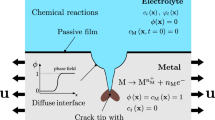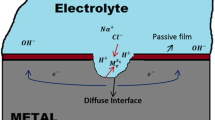Abstract
A system of equations is formulated and solved for the dissolution model of a defect-free crystal with a simple cubic packing, which describes self-consistence of the atomic structure of a dissolving surface (including the edge concentration) and the dissolution rate. The enhanced corrosion resistance is shown to be associated with a small (edge concentration compared with that typical of a real defective crystal.
Similar content being viewed by others
REFERENCES
Alekseev, Yu.V., Alekseev, G.Yu, and Bityurin, V.A., Zashch. Met., 2002, vol. 38, no. 6, p. 580.
Kreuchen, K., Z. Phys. Chem. A, 1931, vol. 155, p. 161.
Skorcheletti, V.V., Teoreticheslie osnovy korrozii metallov (Theoretical Basics of Metal Corrosion), Leninrad: Khimiya, 1973.
Volmer, M., Kinetics of New Phase Formation, Moscow: Nauka, 1986.
Materialovedenie (Material Science), Arzamasov, B.N., Ed., Moscow: Mashinistroenie, 1986.
Author information
Authors and Affiliations
Rights and permissions
About this article
Cite this article
Alekseev, G.Y., Alekseev, Y.V. & Bityurin, V.A. Simplified Topographic Model of Metal Dissolution: Comparison of Metals with Ideal and Real Lattices. Protection of Metals 39, 521–536 (2003). https://doi.org/10.1023/B:PROM.0000007845.83069.7b
Issue Date:
DOI: https://doi.org/10.1023/B:PROM.0000007845.83069.7b




